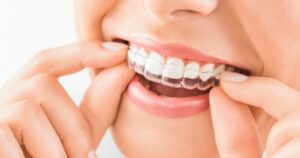Having braces is a significant step towards achieving a straight, healthy smile. However, it’s not uncommon for individuals with braces to experience some discomfort as they adjust to this orthodontic treatment. This is where orthodontic wax, a small yet incredibly useful tool, comes into play. In this guide, we will explore the world of orthodontic wax and show you how to use it effectively to enhance your braces-wearing experience.
At My Smile Orthodontics, we understand that comfort during your orthodontic journey is paramount. That’s why we’re here to provide you with valuable insights on how to make the most out of orthodontic wax. Whether you’re a new braces wearer or looking for tips to improve your comfort, this article will walk you through the ins and outs of using wax for braces. So, let’s dive in and discover how this simple solution can help you smile through your braces journey with ease.
What is Orthodontic Wax?
Orthodontic wax, often referred to simply as braces wax or dental wax, is a soft and pliable substance designed to alleviate the discomfort caused by braces. It’s a small yet invaluable tool for anyone undergoing orthodontic treatment, especially during the initial adjustment period.
This wax is usually made from a blend of natural waxes, such as beeswax, and is completely safe to use in your mouth. It comes in small, easy-to-carry containers that you can keep in your pocket, bag, or at home. When you have braces, orthodontic wax can be your best friend in times of irritation and soreness.
The primary purpose of orthodontic wax is to provide a protective barrier between your braces and the sensitive tissues of your mouth, such as your cheeks and lips. The brackets, wires, and other components of braces can sometimes create friction against these tissues, resulting in discomfort, small sores, or ulcers. Orthodontic wax helps to minimize this friction, preventing irritation and allowing your mouth to heal.
In addition to its protective function, orthodontic wax is incredibly easy to use. It’s safe for both children and adults and can be applied in a matter of seconds, offering quick relief from any sharp or rough edges that may cause discomfort.
At My Smile Orthodontics, we often recommend orthodontic wax to our patients as a simple yet effective solution for enhancing their orthodontic experience. It’s an essential tool to keep on hand throughout your braces journey, ensuring your comfort and peace of mind. In the next sections, we’ll explore when and how to use orthodontic wax for maximum relief.
Why Wax is Essential for Braces Wearers
If you’re new to braces, you might wonder why orthodontic wax is considered an essential tool for those undergoing orthodontic treatment. Here are some compelling reasons why wax is a must-have for braces wearers:
Pain and Irritation Relief
One of the most common challenges for individuals with braces is dealing with pain and irritation caused by the brackets and wires. These components can occasionally rub against the sensitive tissues inside your mouth, leading to discomfort, sores, or ulcers. Orthodontic wax provides a simple and effective way to alleviate this pain. By applying a small amount of wax to the problematic area, you create a protective barrier that prevents further friction.
Preventing Oral Sores
Without the use of wax, braces wearers are more susceptible to developing sores or small ulcers in their mouths. These sores can be painful and may hinder your ability to eat, speak, or maintain proper oral hygiene. Orthodontic wax acts as a cushion, reducing the chances of these sores forming and giving any existing ones a chance to heal.
Enhancing Comfort
Braces can take some time to get used to, and during the initial adjustment period, they might cause minor discomfort. Orthodontic wax can make this transition much smoother by minimizing the impact of braces on your oral tissues. This can be especially beneficial for children and teenagers who might find it challenging to adjust to braces initially.
Protecting Your Lips and Cheeks
Your lips and cheeks are sensitive and can easily become irritated or injured by braces. Orthodontic wax serves as a protective barrier between your braces and these soft tissues, preventing chafing and injuries. This means you can go about your daily activities without the worry of constant irritation.
Easy to Apply and Remove
Using orthodontic wax is straightforward. Simply take a small piece of wax, roll it into a ball, and apply it to the area causing discomfort. When you no longer need the wax, it’s easy to remove without leaving any residue or damage to your braces. This convenience makes it a practical solution for on-the-go relief.
Overall, orthodontic wax plays a vital role in ensuring that your orthodontic journey is as comfortable and pain-free as possible. At My Smile Orthodontics, we understand the importance of this simple yet effective tool, and we’re here to provide guidance on its use throughout your treatment. In the next section, we’ll explore the situations in which you might need to use orthodontic wax and how to apply it correctly.
When to Use Wax
Knowing when to use orthodontic wax is key to maintaining a comfortable braces-wearing experience. Here are some situations where you might find wax especially helpful:
Wire and Bracket Irritation
If a wire or bracket is causing irritation or poking the inside of your cheeks, lips, or tongue, it’s a perfect time to use wax. Simply place a small piece of wax over the offending part to create a smooth surface and prevent further discomfort.
Sharp Edges
Sometimes, the edges of brackets or wires can feel sharp due to recent adjustments or changes. Applying wax over these edges can help dull the sharpness and minimize potential injuries to your oral tissues.
Loose Bands or Wires
In the event that a band or wire becomes loose or dislodged, wax can provide a temporary solution until you can see your orthodontist for repair. Covering the loose component with wax will keep it in place and prevent it from causing irritation.
Mouth Sores
If you develop small sores or ulcers in your mouth, applying wax can help protect them from further irritation caused by the braces. This can speed up the healing process and make it more comfortable to eat and speak.
Orthodontic Emergencies
In situations where you experience an orthodontic emergency, such as a wire poking your cheek or a bracket coming loose outside of regular office hours, orthodontic wax can provide immediate relief until you can get professional assistance.
Remember that orthodontic wax is temporary and should not replace professional advice or adjustments provided by your orthodontist. If you’re unsure whether to use wax or need guidance on its application, don’t hesitate to reach out to My Smile Orthodontics. Our team is here to support you throughout your orthodontic journey.
How to Apply Wax on Braces
Applying orthodontic wax to your braces is a straightforward process. Here’s a step-by-step guide to help you use wax effectively:
Gather Your Supplies
Before you start, ensure you have these items on hand:
- Orthodontic wax: You can get this from your orthodontist or at most drugstores.
- Clean hands: Wash your hands thoroughly to avoid introducing bacteria into your mouth.
- Mirror: Use a mirror to get a clear view of your braces and the area where you need to apply the wax.
Prepare the Wax
Take a small piece of wax, about the size of a small pea. It’s essential not to use too much as you want the wax to adhere comfortably without feeling bulky.
Roll the Wax
Roll the small piece of wax between your clean fingers to soften it. Rolling it into a small, cylindrical shape can make it easier to apply.
Identify the Problem Area
Use a mirror to locate the specific area in your mouth where your braces are causing irritation or discomfort. This could be a bracket, wire, or another part of your braces.
Apply the Wax
Gently press the softened wax onto the part of your braces that’s causing the issue. Make sure it adheres firmly and covers the sharp or irritating component completely.
Check and Adjust
Use your tongue to confirm that the wax is securely in place. It should provide a smooth surface and alleviate any discomfort. If you still feel irritation or if the wax falls off, repeat the process.
Maintain Good Oral Hygiene
While using wax, continue to maintain your regular oral hygiene routine. Brush your teeth, floss, and rinse your mouth as directed by your orthodontist. Wax should be used as a temporary solution, and any ongoing issues should be discussed with your orthodontic team.
Remember that using wax for braces is a quick and easy way to minimize discomfort caused by your orthodontic appliances. If you find that you need to use wax frequently or if you have any concerns about your braces, contact My Smile Orthodontics for professional guidance and adjustments.
Tips for Maximum Comfort
Using orthodontic wax for your braces can significantly enhance your comfort during orthodontic treatment. Here are some tips to ensure you get the most out of your wax:
Keep Wax Handy
Carry a small container of orthodontic wax with you at all times. You never know when a wire or bracket might start causing irritation, and having wax readily available will allow you to address the issue promptly.
Practice Proper Hygiene
Before applying wax, make sure your hands are clean. This helps prevent introducing bacteria into your mouth. Wash your hands thoroughly with soap and water.
Dry the Area
Ensure the area where you plan to apply the wax is dry. Moisture can make it challenging for the wax to adhere properly. You can use a piece of tissue to dry the area gently.
Use the Right Amount
Avoid using too much wax. A small, pea-sized amount should suffice to cover the irritating part of your braces effectively. Overusing wax can lead to discomfort.
Warm the Wax
Soften the wax by rolling it between your fingers. This makes it more pliable and easier to apply. You can also use warm water to soften the wax if needed.
Replace Wax as Needed
Orthodontic wax is not meant to stay on your braces indefinitely. It’s a temporary solution. If the wax falls off or loses its effectiveness, remove it and apply a fresh piece.
Consult Your Orthodontist
If you find that you need to use wax frequently or experience persistent discomfort, consult your orthodontic team. They can assess your braces and make necessary adjustments to alleviate the issue.
Practice Patience
It might take a little time to get the hang of applying wax. Don’t get discouraged if it doesn’t work perfectly the first time. With practice, you’ll become more adept at using it effectively.
Maintain Oral Hygiene
Continue to brush and floss your teeth regularly as instructed by your orthodontist. Wax should not be a substitute for proper oral hygiene.
Stay Consistent
If you have multiple areas causing irritation, address them one at a time with small pieces of wax. This allows you to manage discomfort systematically.
By following these tips, you can maximize your comfort while wearing braces and ensure that orthodontic wax serves as a helpful solution during your treatment. If you have any concerns or questions about using wax or your braces, don’t hesitate to reach out to My Smile Orthodontics for guidance and support.
Wax Removal and Replacement
Knowing how to properly remove and replace orthodontic wax is essential for maintaining your comfort during braces treatment. Here’s a step-by-step guide on how to do it effectively:
Removing Wax:
Wash Your Hands
Begin by washing your hands thoroughly with soap and water. This step is crucial to prevent introducing any bacteria into your mouth.
Inspect the Wax
Check the wax you applied for any food particles or debris. If you notice any, gently remove them using a toothbrush or dental floss.
Use a Mirror
Find a well-lit area and use a mirror to get a clear view of your braces. This will help you identify the areas where wax needs to be removed.
Gently Pry the Wax
Take a clean, unused toothpick or the tip of a dental floss threader. Carefully insert it beneath the edge of the wax you want to remove. Avoid using excessive force, as this can damage your braces or cause discomfort.
Lift the Wax
Once you have inserted the toothpick or floss threader, gently lift the wax away from your braces. Be patient and avoid any sudden or forceful movements.
Clean the Area
After successfully removing the wax, make sure to clean the area where it was applied. Use a toothbrush or dental floss to remove any residue or remaining wax particles.
Replacing Wax:
Prepare the Area
Ensure that the area where you plan to apply wax is clean and dry. Use a tissue or clean cloth to gently dry the spot.
Warm the Wax
Soften a small piece of wax by rolling it between your fingers. You can also use warm water to make it more pliable.
Apply the Wax
Take the softened wax and gently mold it onto the part of your braces that’s causing irritation. Use your fingers to shape it and ensure it adheres securely.
Smooth and Blend
After applying the wax, use your fingertip to smooth and blend the edges. This helps the wax stay in place and prevents it from catching on your lips or cheeks.
Check for Comfort
Close your mouth gently and check for any remaining discomfort or irritation. If needed, make further adjustments to the wax to ensure maximum comfort.
Replace as Necessary
Orthodontic wax is a temporary solution. If it falls off, loses its effectiveness, or if you have new areas of irritation, remove the old wax and repeat the process as needed.
Remember, using orthodontic wax is a skill that improves with practice. Don’t be discouraged if it takes a few attempts to get it just right. If you ever have questions or concerns about using wax or your braces, feel free to reach out to My Smile Orthodontics for guidance and support.
Conclusion
Learning how to use orthodontic wax for your braces is a valuable skill that can significantly enhance your orthodontic journey. At My Smile Orthodontics, we understand that the road to a beautiful, straight smile can sometimes involve moments of discomfort. That’s why we’re here to provide you with not only exceptional orthodontic care but also the knowledge and tools to ensure your comfort throughout the process.
By understanding what orthodontic wax is, why it’s essential, when to use it, and how to apply and remove it properly, you’re empowered to take control of your comfort. Whether you’re dealing with irritating wires, brackets, or other components of your braces, wax can be your go-to solution to alleviate discomfort and prevent any irritation from hindering your orthodontic progress.
If you ever have questions about using wax, face challenges with your braces, or need guidance on your orthodontic journey, our team at My Smile Orthodontics is here to support you. Your comfort and satisfaction are our top priorities, and we’re committed to helping you achieve the smile you’ve always dreamed of.
Remember, while orthodontic wax can provide temporary relief, it’s important to keep up with your regular orthodontic appointments and follow the guidance of your orthodontist. With dedication, proper care, and the support of My Smile Orthodontics, you’re well on your way to a confident and radiant smile. Don’t hesitate to reach out to us whenever you need assistance, and let’s work together to make your orthodontic experience as comfortable and successful as possible.













